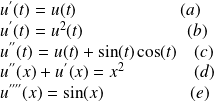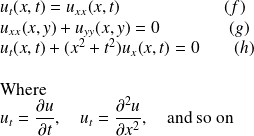What is a differential equation
The field of differential equations is very rich and contains a variety of different species. However, there is a basic feature to all problems defined by differential equation: the equation relates a function
 to its derivatives in such a way that the function itself can be determined.
to its derivatives in such a way that the function itself can be determined.
The differential equations can be subdivided into Partial Differential Equations (PDEs) and Ordinary differential Equations (ODE). In PDEs we deal with partial derivatives, whereas ODEs involve only derivatives with respect to one variables. We can give some typical ordinary differential equations:

The above equation are ODEs of different order (first, second and fourth).
We can also give some typical partial differential equation:

For the most environmental complex systems, their dynamics is described using PDEs.





